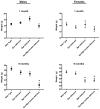Phenotypic characterization of epiphycan-deficient and epiphycan/biglycan double-deficient mice
- PMID: 19932218
- PMCID: PMC3013283
- DOI: 10.1016/j.joca.2009.11.006
Phenotypic characterization of epiphycan-deficient and epiphycan/biglycan double-deficient mice
Abstract
Objective: To characterize the in vivo role epiphycan (Epn) has in cartilage development and/or maintenance.
Methods: Epn-deficient mice were generated by disrupting the Epn gene in mouse embryonic stem cells. Epn/biglycan (Bgn) double-deficient mice were produced by crossing Epn-deficient mice with Bgn-deficient mice. Whole knee joint histological sections were stained using van Gieson or Fast green/Safranin-O to analyze collagen or proteoglycan content, respectively. Microarray analysis was performed to detect gene expression changes within knee joints.
Results: Epn-deficient and Epn/Bgn double-deficient mice appeared normal at birth. No significant difference in body weight or femur length was detected in any animal at 1 month of age. However, 9-month Epn/Bgn double-deficient mice were significantly lighter and had shorter femurs than wild type mice, regardless of gender. Male Epn-deficient mice also had significantly shorter femurs than wild type mice at 9 months. Most of the deficient animals developed osteoarthritis (OA) with age; the onset of OA was observed earliest in Epn/Bgn double-deficient mice. Message RNA isolated from Epn/Bgn double-deficient knee joints displayed increased matrix protein expression compared with wild type mice, including other small leucine-rich proteoglycan (SLRP) members such as asporin, fibromodulin and lumican.
Conclusion: Similar to other previously studied SLRPs, EPN plays an important role in maintaining joint integrity. However, the severity of the OA phenotype in the Epn/Bgn double-deficient mouse suggests a synergy between these two proteins. These data are the first to show a genetic interaction involving class I and class III SLRPs in vivo.
Copyright 2009. Published by Elsevier Ltd.
Conflict of interest statement
No conflicts of interests are associated with this manuscript.
Figures






References
-
- Johnson J, Shinomura T, Eberspaecher H, Pinero G, Decrombrugghe B, Hook M. Expression and localization of PG-Lb/epiphycan during mouse development. Dev Dyn. 1999;216:499–510. - PubMed
-
- Roughley PJ. The structure and function of cartilage proteoglycans. Eur Cell Mater. 2006;12:92–101. - PubMed
-
- Winnemoller M, Schon P, Vischer P, Kresse H. Interactions between thrombospondin and the small proteoglycan decorin: interference with cell attachment. Eur J Cell Biol. 1992;59:47–55. - PubMed
-
- Dugan TA, Yang VW, McQuillan DJ, Hook M. Decorin modulates fibrin assembly and structure. J Biol Chem. 2006 - PubMed
Publication types
MeSH terms
Substances
Grants and funding
LinkOut - more resources
Full Text Sources
Other Literature Sources
Molecular Biology Databases
Miscellaneous

